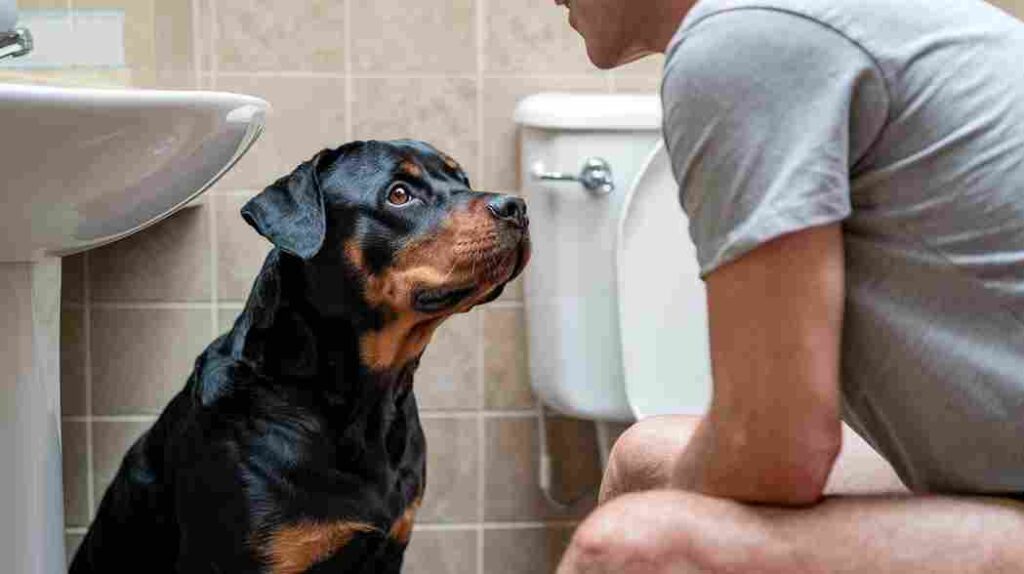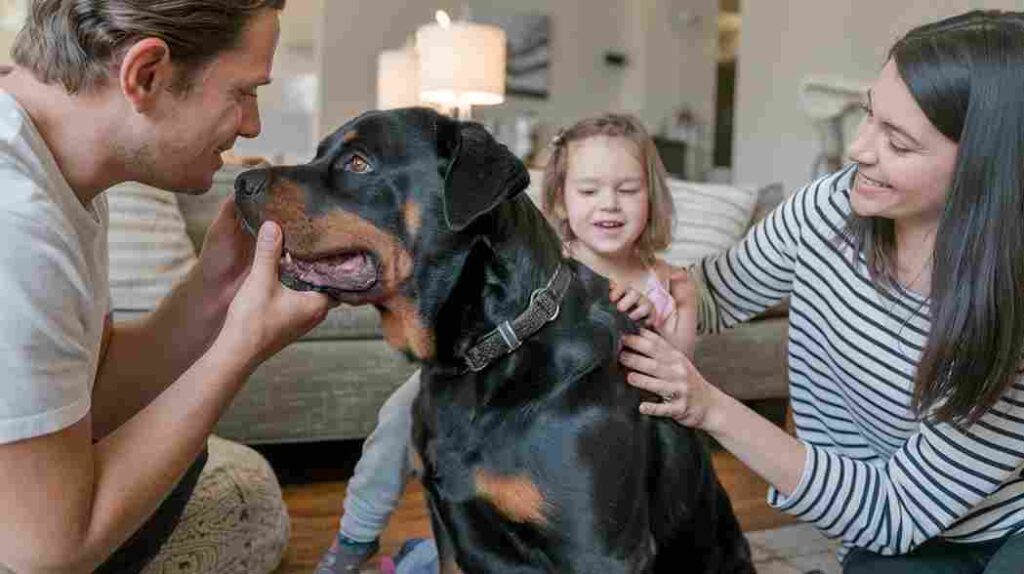Why Are Rottweilers So Clingy? Key Takeaways:
-
-
Protection is a priority: They stick to you because they want to protect you; it's in their guardian-dog DNA.
-
They're emotional detectives: Rottweilers are highly sensitive to your moods and want to be there for you.
-
Love language = clinginess: Their "velcro dog" behavior is how they show affection and loyalty.
-
They're not always clingy: Rottweilers can be independent too, but they thrive with a job and close bond with their family.
Last night, while sitting on my “throne,” I glanced down to find Max’s big brown eyes staring up at me. And no, my 3-year-old Rottweiler wasn’t waiting for his bathroom break. He was just doing what he does best – being my faithful shadow, even during my most private moments.
If you’re a Rottweiler parent, this scenario probably sounds all too familiar. From the living room to the kitchen, bedroom to bathroom, these gentle giants seem to have an internal GPS locked on their humans. They follow us everywhere with such dedication that they’ve earned the nickname “Velcro dogs” – and trust me, that velcro part is no exaggeration.

It’s a funny paradox, isn’t it? These powerful dogs, known for their imposing presence and sometimes intimidating appearance to strangers, turn into the clingiest, most adorable shadows with their family. They’re the same breed that can make a stranger think twice about approaching your house, yet they can’t bear the thought of you closing the bathroom door without them.
But here’s the million-dollar question: Why would a breed with such a noble and independent heritage become what many call “overly attached?” Why does your tough-looking guardian insist on being your personal bathroom attendant?
The answer might surprise you – and no, it’s not just about separation anxiety or neediness as many people think. There’s something far more fascinating happening in that big, beautiful Rottie brain of yours…
The Science Behind Your Rottweiler's "Velcro Dog" Behavior

Let’s get one thing straight – your bathroom-stalking Rottweiler isn’t just being needy. In fact, this behavior is wired into their DNA in ways that might blow your mind.
Think of your Rottie like an ancient German software program that’s been perfectly coded for one specific purpose: staying connected with their humans. Back in their homeland, these dogs weren’t just hanging out in backyards looking tough. They were working alongside farmers and butchers, watching and protecting both the person and their property. This wasn’t a part-time gig – it was a 24/7 commitment.
Here’s where it gets interesting: Your Rottweiler’s brain is actually hardwired for what scientists call “cooperative behavior.” Unlike some independent breeds who’d rather do their own thing (looking at you, huskies), Rotties are programmed to work in sync with their humans. It’s not just following – it’s active participation in your life.
And that intense stare you get when you’re just minding your own business? That’s your Rottie’s ancient instincts at work. They’re not just watching you – they’re reading you. These dogs can pick up on the slightest change in your breathing, posture, or mood. It’s like having a four-legged emotional detective who’s constantly making sure you’re okay.
But here’s the kicker – this “clingy” behavior actually serves a purpose. The science behind your Rottweiler’s attachment behavior is more fascinating than you might think. A groundbreaking 2023 study published in the Applied Animal Behaviour Science journal has uncovered remarkable patterns in working breed psychology. The research, conducted over three years with 1,200 dogs, revealed that Rottweilers possess unique neural pathways specifically dedicated to human bonding. These findings help explain why your bathroom breaks are never solo adventures and why your Rottweiler seems to have an invisible tether to your movements.
So the next time your Rottweiler follows you to the kitchen for the hundredth time today, remember: You’re not dealing with a needy shadow – you’re living with a highly sophisticated, genetically optimized companion who’s doing exactly what generations of careful breeding designed them to do. Pretty cool, right?
Do Rottweilers Really Choose One Person? The Loyalty Factor

You’ve probably heard the rumors – “Rottweilers are one-person dogs.” Well, like most family gossip, there’s a bit of truth mixed with a whole lot of misconception here.
Let me tell you about my friend Sarah and her Rottie, Duke. Everyone in the family was convinced Duke was “Sarah’s dog” because he followed her around like a furry bodyguard. But here’s what they missed: While Duke watched Sarah like a hawk, he was actually keeping tabs on everyone in his own unique way. He’d check on the kids during homework time, escort Dad to the garage, and yes, guard Mom (Sarah) like she was carrying the crown jewels.
Here’s what’s really going on: Rottweilers don’t so much choose “one person” as they develop a complex social map of their family. Think of them less like a personal bodyguard and more like a highly efficient security system with different protocols for different family members.
They might show their attention in different ways:
- The intense velcro behavior with the primary caregiver
- The gentle shadowing of kids
- The alert monitoring of other family members
- The protective positioning when visitors are around
But here’s where it gets fascinating: Your Rottie might appear more “attached” to whoever matches their energy level and engagement style. It’s not favoritism – it’s compatibility! If you’re the one taking them on adventures, training sessions, and giving them “jobs” to do, of course they’re going to stick to you like glue. You’re basically their favorite coworker!
I’ll never forget watching my neighbor’s Rottie, Bear, during family gatherings. While he’d stay closest to his “main person,” he had this incredible way of repositioning himself throughout the house to keep an eye on every family member. It wasn’t clingy behavior – it was more like a master choreographer keeping all their dancers in view.
The truth is, your Rottweiler’s loyalty isn’t exclusive – it’s expansive. They’re capable of forming deep, meaningful bonds with multiple family members. The “clinginess” you see is just their way of showing that hey, you’re all part of their crew, and they take their crew membership very seriously.
Your Rottweiler's "Clingy Behaviors" Decoded

Ever feel like you need a secret decoder ring to understand why your Rottie does what they do? Let’s crack the code on some of these “stalker-like” behaviors that make us laugh (and sometimes roll our eyes).
The Bathroom Bodyguard Routine There you are, trying to have a moment of peace, and… yep, there’s that nose under the door. Why? Your Rottie isn’t being weird – in their mind, you’re at your most vulnerable when, ahem, indisposed. They’re literally standing guard! Think of it as having a very dedicated (if somewhat awkward) personal security detail.
The Lean Machine You’re standing in the kitchen, and suddenly – THUMP – you’ve got 100 pounds of Rottweiler pressed against your leg. This isn’t your dog being needy; it’s actually a power move! It’s their way of saying, “Hey, I’ve got your back… literally.” This behavior goes back to their working dog roots – staying in physical contact to communicate and coordinate.
The Shadow Dance That constant shuffle-step behind you as you move through the house? Your Rottie is basically running a continuous security sweep. They’re not just following you – they’re maintaining optimal position for both protection and response. Pretty professional, right?
The Stare-Down Champion Ever feel like you’re being watched? Those intense brown eyes tracking your every move aren’t judging your snack choices (okay, maybe a little). This is your Rottie’s way of reading your story. They’re picking up on tiny changes in your expression, posture, and mood – like a furry emotional barometer.
The Velcro Nap Attack When your Rottie insists on sleeping touching you – whether it’s a paw, their head, or their whole body pressed against you – they’re actually multitasking. They’re resting AND maintaining their protective position. It’s like they’re saying, “Even in my sleep, I’ve got you covered, boss!”
Here’s the thing that makes all this extra interesting: These behaviors aren’t signs of an insecure dog. Quite the opposite! They’re displays of a confident, well-adjusted Rottweiler doing exactly what they were bred to do – keep their humans safe, monitored, and yes, thoroughly supervised in the bathroom.
Male vs Female: The Attachment Difference
Let’s tackle the age-old question that makes Rottweiler owners debate like it’s a championship match: Do male and female Rotties have different “clingy styles”? Spoiler alert: They do, but not in the way most people think.
The Boys Club Meet Zeus, my neighbor’s male Rottie. He’s what I call a gentle giant goofball. While everyone claims male Rotties are more independent, Zeus didn’t get that memo. His version of clinginess? Think of a 120-pound lap dog who genuinely believes he’s still puppy-sized.
Male Rottweilers often show their attachment through:
- Physical presence (AKA sitting ON you)
- Playful attention-seeking (Yes, that’s your sock in his mouth… again)
- Constant “check-ins” (Those drive-by licks while you’re working)
- Obvious showing off (“Look, Mom, I brought you the WHOLE garden hose!”)
The Ladies’ Approach Now, let’s talk about Luna, my friend’s female Rottie. She’s got what I call strategic clinginess down to an art form. Female Rotties often display their attachment with more… shall we say, sophistication?
Their signature moves include:
- Subtle surveillance (You just THINK they’re napping)
- Calculated closeness (Always within eyesight, not necessarily touching)
- Protective positioning (Between you and the door, always)
- Emotional intelligence (They know you’re sad before YOU know you’re sad)
The Age Factor Here’s where it gets really interesting – both genders go through what I call the “velcro evolution“:
- Puppies (0-1 year): Equal opportunity stick-to-everyone
- Teenagers (1-2 years): Testing independence (sort of)
- Young Adults (2-4 years): Developing their signature style
- Mature (4+ years): Masters of their chosen attachment technique
But here’s the real truth that nobody talks about: Individual personality trumps gender every time. I’ve met female Rotties who could out-cuddle any male, and male Rotties with the subtle sophistication usually attributed to females.
The secret isn’t in their gender – it’s in understanding your specific Rottie’s love language. Some speak it through constant physical contact, others through watchful distance, and some (let’s be honest) through stealing your entire sock collection.
When Clinginess Becomes Concern
Let’s talk about that fine line between “normal Rottie radar” and “Houston, we have a problem.” Because yes, there is such a thing as too much of a good thing – even when it comes to your four-legged shadow.
The Normal Nominee First, let’s paint a picture of your typical clingy (but totally fine) Rottweiler:
- Follows you around but can chill independently
- Checks on you frequently but can settle when asked
- Watches the door when you leave but doesn’t panic
- Guards your bathroom breaks but survives if denied entry (dramatic sighs included)
The Red Flag Regiment Now, here’s when you might want to raise an eyebrow:
- Destructive behavior when left alone (RIP, couch cushions)
- Excessive drooling or panting when you reach for your keys
- Refusing to eat when you’re not home
- That heart-breaking cry-howl that makes your neighbors think you’re torturing your dog
- Aggressive attempts to prevent you from leaving

Here’s a real story: My friend’s Rottie, Tank, started showing extreme attachment after a move. We’re talking full-on panic attacks when she stepped outside. The difference? This wasn’t his usual “velcro vibe” – this was genuine distress.
The Fix-It Formula If you’re seeing red flags, here’s your action plan:
- Start with baby steps separation training
- 30 seconds in another room
- Then 1 minute
- Building up slowly (like, seriously slowly)
- Create a safe space
- Their own “apartment” (crate or designated area)
- Favorite toys
- Something with your scent (that you don’t mind being destroyed)
- The calm departure
- No dramatic goodbyes
- No “I’ll be right back” promises
- Just cool, casual confidence
Remember: Most Rottie clinginess is normal and even charming (in a 100-pound-shadow kind of way). But if your gut tells you something’s off, listen to it. There’s no shame in reaching out for professional help – sometimes we all need a little guidance in the attachment department.
-
Pro Tip: The goal isn't to eliminate their clingy nature (good luck with that anyway). It's about finding that sweet spot between devoted companion and independent thinker.
The Protective Nature Behind The Cling
Let’s dive into the real reason your Rottweiler thinks they’re your personal Secret Service agent. There’s a fascinating link between their “can’t-let-you-out-of-my-sight” behavior and their deep-rooted protective instincts.
Mission: Protection Picture this: Your Rottie isn’t just following you to the kitchen for the 47th time today – they’re actually on active duty. In their mind, they’re running some pretty serious security protocols:
- Perimeter checks (aka following you everywhere)
- Threat assessment (staring at that suspicious Amazon package)
- Asset protection (that’s you, by the way)
The Bodyguard Blueprint Remember that scene from The Bodyguard? Your Rottie would totally relate. Here’s what’s actually happening when they’re being “clingy”:
- That lean against your leg? Strategic positioning for quick response
- The door escort service? Checking for threats before you enter
- Those random wake-up checks at night? Midnight security rounds
- The between-your-legs maneuver in crowds? Standard protection formation
Love vs. Protection: The Great Debate Here’s where it gets interesting. Your Rottie’s behavior is actually a brilliant fusion of:
- Deep family bonds (love)
- Guardian instincts (duty)
- Working dog heritage (purpose)
Think of it like this: They’re not clingy because they’re needy; they’re close because they’re dedicated to their job. And guess what? You’re their full-time job!
Real Talk Time Story time: My Rottie, Max, once spent an entire evening positioned between me and a new maintenance guy working in our apartment. He wasn’t being aggressive – just diplomatically concerned. That’s your typical Rottie: not paranoid, just… professionally cautious.
The Sweet Spot Balance The key is understanding that your Rottie’s protective nature:
- Isn’t anxiety (usually)
- Doesn’t need “fixing”
- Should be channeled, not suppressed
Pro Tips for Working With Their Nature:
- Give them “observation posts” in each room
- Acknowledge their “security alerts” (even if it’s just the mailman)
- Provide “official duties” (watching you cook counts!)
- Allow them to “clear” new spaces or meet new people properly
Remember: Your Rottweiler’s combination of clinginess and protection isn’t a flaw – it’s a feature! They’re literally hardwired to be your personal security detail, complete with unlimited cuddles and occasional dramatic sighs.
Your Burning Rottie Questions Answered (FAQ)
Why does my Rottweiler follow me to the bathroom... EVERY. SINGLE. TIME?
Plot twist: This isn't just your Rottie being weird. They know you're in a vulnerable position (literally), and guess what? In their mind, you've just entered a small cave with only one exit. They're not being nosy - they're being your personal bathroom bodyguard. Congratulations, you now have the world's most dedicated bathroom attendant!
Are Rottweilers good family dogs with this clingy behavior?
Absolutely! Their "clinginess" actually makes them exceptional family dogs. Think of them like that super-dedicated hall monitor from school, except they're monitoring your family's safety and happiness. They'll keep tabs on the kids, escort your spouse to the car, and still have energy to be your personal couch companion.
How do Rottweilers show affection besides stalking me?
Oh, let me count the ways:
- The famous Rottie lean (your leg is their favorite wall)
- Drive-by licks (surprise affection attacks)
- The wiggle butt greeting (no tail needed)
- Gentle headbutts (their version of a love tap)
- The paw placement (Yes, that heavy paw on your foot is intentional)
Can you train a Rottweiler to be less clingy?
Here's the thing: Can you? Yes. Should you? That's debatable. It's like trying to train a fish not to swim. Instead, focus on building their confidence and independence while appreciating their natural protective instincts. Besides, who else is going to alert you to the deadly threat of... checks notes... the neighbor's garden gnome?
Do Rottweilers get more clingy with age?
Like fine wine and cheese, Rottie clinginess often matures with age. Young Rotties might be busy investigating everything, but seniors perfect the art of the strategic snuggle. They become more subtle, more sophisticated in their surveillance - less "in-your-face" and more "I'm-just-casually-watching-your-every-move."
Is my Rottweiler clingy or protective?
Plot twist: It's usually both! Here's a quick test:
- Clingy: "I must be touching you at all times because I love you"
- Protective: "I must be near you at all times because it's my job"
- Your Rottie: "Why choose? I'll do both!"
Should I worry if my Rottweiler suddenly becomes more clingy?
Sudden personality changes are always worth noting. If your usually semi-independent Rottie suddenly turns into your second skin, pay attention. Could be:
- They're not feeling well
- They sense something you don't
- They're picking up on your stress
- That new air freshener is suspicious and requires 24/7 monitoring
Final Thoughts: Embracing Your Velcro Rottie
Let’s be real – having a Rottweiler means never walking alone… or cooking alone… or, well, doing anything alone. But here’s the beautiful truth: Their “clinginess” isn’t a flaw, it’s their love language written in loyalty.
When your Rottie follows you from room to room, they’re not just being needy – they’re fulfilling a purpose wired into their DNA over generations. They’re part bodyguard, part emotional support, and full-time family member who takes their job incredibly seriously.
So the next time someone asks, “Why is your Rottweiler so clingy?” just smile and tell them: “They’re not clingy – they’re professionally devoted.” Because at the end of the day, having a Rottweiler means having a shadow with a heartbeat, a protector with paws, and a friend who believes that every moment shared is a moment made better.
And honestly, who wouldn’t want that kind of dedication in their life?
Want to take your bond with your clingy Rottweiler to the next level? Check out our Rottweiler Training: The Complete Guide [Expert Tips & Techniques] for expert tips on training, managing clinginess, and channeling their protective instincts!







